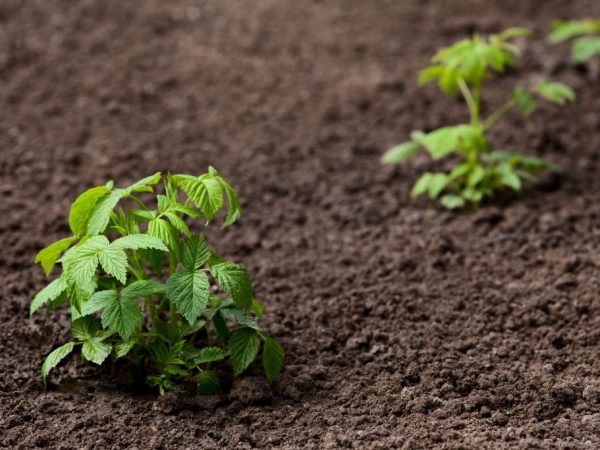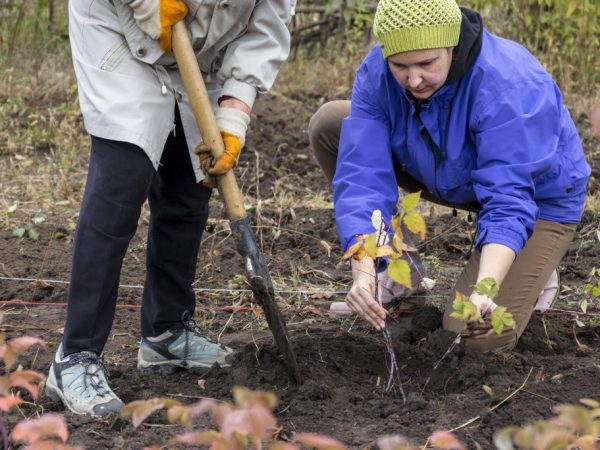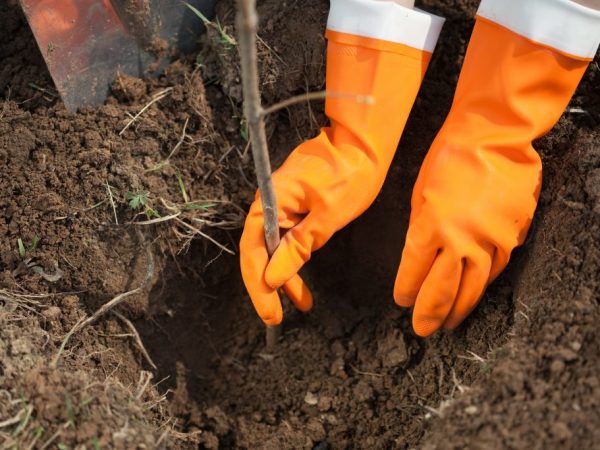Autumn raspberry transplant rules - secrets of experienced gardeners
It is undesirable to grow raspberries for a long time in the same place. To obtain more abundant harvests, it is advisable to transplant in the fall, and then create the most favorable conditions. In order not to harm the plant, they carry out the procedure carefully, observing agrotechnical rules.

Autumn raspberry transplant rules
The purpose of the autumn transplant
Some gardeners do not consider it necessary to transplant raspberry bushes, and in vain. The culture needs to change the place of growth, and the main reason is a gradual decrease in yield when being in the same area. The displaced plant rejuvenates, which has a positive effect on the size and quality of the crop.
Main reasons:
- raspberries significantly deplete the soil, which makes the fruits tasteless and small;
- bushes are attacked by insects, immunity to diseases is reduced;
- an overgrown raspberry tree captures a large space, the effect of high humidity is created in thickening, which increases the likelihood of fungal infections;
- transplanting before the onset of winter stimulates the formation of shoots;
- the renewed bushes look attractive again and decorate the garden.
The plant should be transplanted every 5 years. But this is not an exact date. If it develops well on the current site, gives a generous harvest, there are no traces of infection and pests, then you can postpone the procedure for another couple of seasons.
Optimal timing
The optimal period for the autumn raspberry transplant is from mid-September to mid-October. But the terms in each region may be shifted taking into account climatic conditions.
The main rule is to have time to carry out the procedure a month before the onset of frost. This time is enough for the root system to adapt to the new site.
If less than a month remains, then it is better to abandon the transfer of plantings, because there is a high probability that the plant will not have time to take root and will die in winter. In this case, the move is best done in the spring.
Lunar calendar
Most gardeners, when carrying out work on the garden plot, are guided by the dates indicated in the lunar calendar.
Optimal days for autumn 2019:
- September - 3rd number (4-5 lunar days), 4 (5-6), 5 (6-7);
- October - 1 (3-4), 2 (4-5), 29 (2-3).
On these days, plant juices under the influence of the Moon move from shoots to roots, which has a beneficial effect on rooting. But this does not mean at all that in another autumn period the transfer of raspberries to a new site will end unsuccessfully.
By region
Most experienced gardeners are weather-oriented. It is imperative to replant the raspberries according to the climatic conditions in the region.
- Northern regions, Siberia, Ural. The procedure is carried out in the summer-autumn period, they try not to delay the matter until mid-September. If in August there is a cold snap with strong winds and regular precipitation, then it is better to transplant in the spring.
- Middle lane, Moscow region, Volga region. You can start the procedure in September. The work must be completed by mid-October. The transfer of raspberries in the autumn period is more successful than in the spring.
- Southern regions. Thanks to the warm and mild climate, it is possible to transplant the berry culture even at the beginning of November.
Seat selection

Raspberries need sunlight
For the full growth and development of the transplanted bush, you need to choose the right new site in the garden. It should be well lit, but without prolonged direct light during the day (shade is not acceptable). It is important to install protection against drafts and winds. Many experienced gardeners try to plant a raspberry tree along the fence.
The best place for a plant is an empty one, on which nothing has grown before. But in reality, such a corner in the garden is difficult to find.
Planting is unacceptable where raspberries used to be located: it can even sprout from pieces of roots left in the ground after digging, and if a new planting is intertwined with seedlings of the old, then it will be problematic to separate them.
When choosing a site, the rules of crop rotation are taken into account. The culture feels best where it used to grow:
- siderates;
- legumes;
- onion garlic;
- zucchini, cucumbers.
Should not be planted where they used to be:
- strawberry beds;
- potatoes;
- currants and gooseberries.
Raspberries are extremely sensitive to the quality of the soil, giving a plentiful and high-quality harvest only with sufficient nutrition. It is advisable to choose a site with loam or sandstone that has a neutral environment.
If the soil in the garden is acidic, then dolomite and chalk are used to neutralize it.
You can fertilize the land in advance, 3-4 months before transplanting, or after preparing the planting hole.
- In the first case, the soil is fertilized with rotted manure or compost, take 7-8 kg / m². Superphosphate (40 g / m²) and potassium sulfate (30 g / m²) are also added. The mineral component can be replaced with ash (1 l / m²).
- In the second, nutrient components are poured into the planting hole, their concentration should be 2 times less.
It is impossible to put the bush directly on fertilizers, otherwise the roots will burn, therefore a layer of fertile soil 5 cm thick is poured on top. If, during the transfer, the soil lump fell apart and the root system was exposed. Do not use fresh manure - this leads to burns.
Plant preparation
In the autumn, it is advisable to deal with the transfer of small berry plantings, but already having a strong and developed root system.
Before the procedure, the plant is examined for the presence of diseases, the characteristics of the variety are determined, and the quality parameters of the soil are checked.
Raspberries are propagated by cuttings and root shoots.
- Cuttings are treated with a solution of copper sulfate. They take root quickly, it is enough to put them in water. You can also use a growth stimulant.
- If root shoots are planted, then they are dug up, separated from the mother plant. The roots are cleaned. Shoots with strong and healthy roots are selected, then immersed in water so that they are saturated with moisture.

Cuttings can be treated with growth stimulants
Transplanting an adult culture, they act like this:
- the bush is carefully dug up, old and diseased roots are cut off, and young, healthy and strong are left.
- the plant is placed for some time in a container with water in which a growth stimulant is dissolved.
Description of technology
Raspberries are transplanted in two ways. The gardener decides which one to choose, focusing on the size of the selected area and his own preferences.
Trench method
Parameters for the trench: width 40 cm, depth 30 cm, distance between bushes - 60-70 cm, length at the discretion of the gardener (for 3-4 plants measure 2 m). It is advisable to fill the bottom with sawdust, twigs, bark, fill it with compost on top. This creates optimal soil conditions, because in nature, raspberries grow next to fallen trees, rotting stumps.
In this way, it is convenient to plant raspberries along the fence.It is also suitable for trellis crops. The plantings are tied to a fishing line stretched between the posts.
Benefits:
- bushes are equally provided with food, moisture, sunlight.
- simple care, less water is consumed for irrigation, weed control is easier, it is more convenient to build a winter shelter;
- the yield is higher.
Landing Algorithm:
- the site is prepared, weeded, fertilized;
- to make it easier to do the work, they put markings - they drive in stakes in the places where the bushes will be placed;
- dig a trench in the direction from north to south (thanks to this arrangement, the plants receive the maximum amount of morning light);
- the groove is filled with organic matter and mineral fertilizers;
- reinforce the sides, use wooden slabs, roofing material;
- on the end sides, T-shaped pillars with a height of about 1 m are driven in;
- between the pillars at two heights, stretch the fishing line (at a distance of 30 cm from the soil surface and at the top of the pillars);
- bushes are planted in a row;
- after planting, the soil is lightly tamped;
- watered abundantly in several approaches so that the earth is fully saturated with moisture, then it is mulched with peat, humus, needles;
- shoots are tied to the fishing line, first to the bottom, then to the top.
Pit method
This method is used if there are few raspberry bushes.
The diameter of the hole should be about 30 cm, the depth is up to 30 cm.The distance between the bushes is 60-70 cm, the row spacing is 2 m.

Fertilizers must be poured at the bottom of the hole
Landing Algorithm:
- digging planting holes;
- organic matter and mineral fertilizers are poured to the bottom;
- fertile soil is poured on top;
- the plant is set in a hole and covered with earth, lightly tamped;
- it is abundantly watered and mulched with sawdust, peat, humus.
Follow-up care
In order for the transplanted raspberry to recover faster and not wither away, it is properly looked after: it is watered, the soil is loosened, and top dressing is carried out.
Experienced gardeners reveal the secrets of proper care:
- After transplanting, the plant is immediately prepared for winter. Some use a covering material, others believe that it is better to bend the branches to the ground, first placing spruce paws under them so that there is no contact with the frozen soil surface. Raspberry is a winter-hardy culture, it is enough to be covered with snow.
- In the northern regions, the bushes are additionally insulated with dense covering material, wooden slabs, slate. The main thing is that air continues to circulate inside.
- After the spring melting of snow, the culture is fed with a mineral complex, ash, organic matter.
- In the summer, they carry out standard care measures: watering, removing weeds, feeding.
Features of transplanting remontant raspberries
The movement of the remontant culture has its own peculiarities. The pit method is usually used.
For the successful implementation of this process, experienced gardeners adhere to the following technology:
- the wells are prepared 3 weeks before work (depth 40 cm, diameter 55 cm, planted according to the scheme 80X150 cm);
- the bottom is laid with nutritious soil;
- install a bush, straighten the roots;
- fall asleep with earth, slightly tamp;
- before the arrival of frost, the plant is watered, mulch is used to preserve soil moisture.
In late October and early November, it is advisable to water the soil around the bushes with a root growth stimulant.
Transplanting raspberries in the fall is an optional procedure. But it allows you to prevent soil depletion, damage to shoots by harmful insects and infectious diseases. The main thing is to take into account the timing, choose the right time and do the work in accordance with agrotechnical rules - and then the culture will delight you with a plentiful and sweet harvest for a long time.

